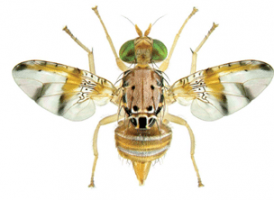Host plants
These fruit flies are highly polyphagous. Ceratitis capitata and C. rosa have been recorded from more than 300 and 100 cultivated and wild hosts respectively, while C. cosyra has also been recorded from a large number of hosts in a variety of plant families. In southern Africa the marula, Sclerocarya birrea (Anacaridaceae) is an important wild host of C. cosyra. An annotated list of the host plants of Ceratitis species is provided De Meyer et al. (2002).
Damage
Damage (illustrated) begins when the female fly punctures the skin of the fruit and lays eggs underneath it. Decay is caused by the larvae feeding in the flesh of the fruit, which renders the fruit unmarketable. Ceratitis cosyra and Ceratitis rosa are the dominant species in mango orchards. Mango fruit are not infested during the early stages of fruit development but are markedly more prone to attack closer to harvest. Fruit that ripen on the tree and are picked for local markets are more prone to attack than mature but green fruit picked for export. Fruit flies are important quarantine pests and indirect losses from quarantine restrictions that are imposed by importing countries, to prevent entry and the possible establishment of unwanted fruit fly species.
Life history
The development rate of these three fruit flies at different temperatures was studied by Grout & Stolz (2007). At 26 ˚C the eggs of C. cosyra took about two days to hatch, the larval stage was close to six days when reared on artificial medium while the pupal stage was about 9-10 days. The mean egg to egg development at 26 ˚C took 20-24 days.
Natural enemies
Several predators and parasitoids, including unidentified species of Fopius, Psyttalia. Opius (all Braconidae) and Tetrastichus (Eulophidae) found in mango agro-ecosystems can contribute to the suppression of fruit flies. Spiders and ants are examples of predators.
Management
Management practices include the use of commercially available traps and lures for monitoring fruit fly populations (Grové et al. 2009) in addition to the following strategies:
Bait stations, bait sprays and attract and kill: Bait stations placed in mango trees are registered for control of fruit flies in mango orchards. Control with bait sprays is based on the use of hydrolysed proteins in combination with an insecticide. The method targets adult flies, especially females and aims to attract and kill them before they can lay eggs in the fruit. The spray should be targeted to the lower surface of the leaves to enhance the persistence of the bait and reduce exposure to the sun and rain. This applies when monitoring data indicate that fruit flies are present in high numbers. Bait applications can be applied weekly depending on monitoring data. A pheromone attractant in combination with a contact insecticide, which is applied in the form of small droplets to the leaves, is also registered.
Natural enemies: Parasitoids and predators which can contribute to the suppression of fruit flies are present in fruit agro-ecosystems. Efforts to conserve natural enemies in commercial orchards through more efficient management, may contribute to the overall suppression of fruit flies.
Orchard sanitation: Orchard sanitation entails the collection and destruction of all fallen fruit from the ground. This can contribute towards the reduction in fruit fly numbers, by preventing the pupation of the maggots in the soil. Fruit must be destroyed by burying it at a depth of 600 mm or putting it through a hammer mill.
Eradication of alternative host plants: Alternative host plants serve as a breeding ground and source of fruit flies and must be eradicated when found in the vicinity of the orchard. Wild growing guava is an example of a weed that hosts fruit flies.








